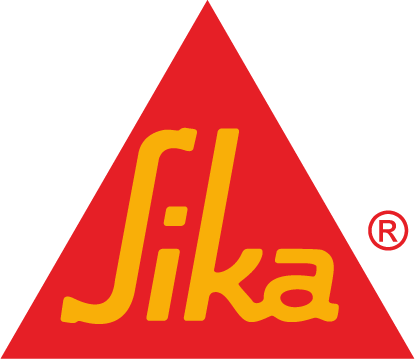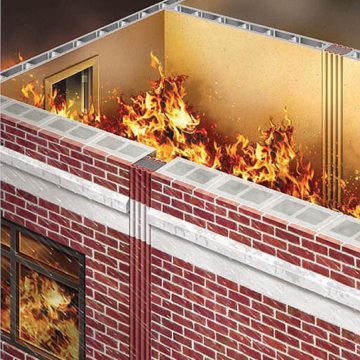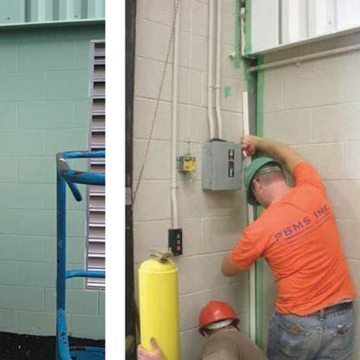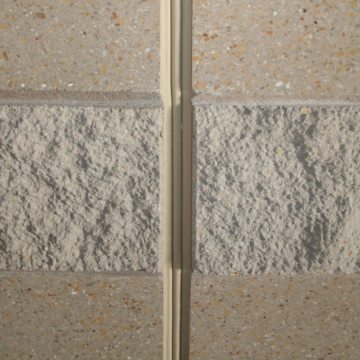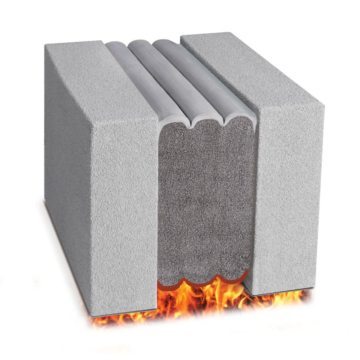Fire Rated Expansion Joints Perform Many Tasks
Fire rated expansion joints are evolving to meet advancing building science.
Today’s wall systems are being designed and constructed to perform a growing number of functions. Beyond simply separating rooms or enclosing a structure, they are expected to maintain thermal conditions, contain the spread of fire and/or smoke, suppress the transmission of sound, and seal out the intrusion of water and wind. But, as with any system, performance is only as good as its weakest link.
Expansion joints historically represent one of the weakest links in wall assemblies. Mandated to accommodate anticipated structural movement, expansion joints are literally a gap or break through the entire system. The ideal expansion joint filler would be one that will not only handle the gap’s expansion and contraction, but also perform all other functions expected of the adjacent wall system.
Why an Expansion Joint
Building materials comprising floors, walls and ceilings move due to thermal expansion and contraction, structural shifts, seismic activity and static and live loading. These forces mandate the need for purpose-designed gaps which permit the building materials to move independently of one another without damage. Smaller planned joint locations are considered control joints while other locations need to accommodate greater movement and therefore require larger gaps. These larger gaps need to be fitted with structural expansion joint fillers. It is important to fill these joints with a sealant or expansion joint system which preserves the attributes of the wall, floor or other building element. These attributes may include a fire-resistance, smoke resistance, sound attenuation, watertightness, wind resistance, or a thermal rating. Many expansion joint systems on the market don’t take into consideration the importance of these requirements and only function on an aesthetic level at best. The ideal solution would match the attributes of the expansion joint system to the requirements of the wall or, at the very least, ensure that the expansion joint material does not degrade any aspect of the wall assembly’s performance.
Early in the design process, an assessment should be made of what is required of the expansion joint system. The proper system should be carefully selected to best match all of the wall’s properties while handling the expected movement. The wrong choice in an expansion joint can allow fire, smoke, moisture, heat and cold, sound, or other unwanted elements to pass through the wall at the location of the expansion joint gap. For example, metal-track-and-rubber-gland systems (“strip seal systems”) which can fill the void and may handle the wall’s movement may not effectively block the passage of sound or provide for watertightness, fire-spread prevention, or thermal insulation. Or, as is often done, fiberglass insulation stuffed behind an expansion joint cover to help meet the wall’s thermal rating becomes ineffective when movement occurs. As the structure cycles at the joint gap, the insulation (which has little elastic memory) is crushed no longer functions as intended.
Precompressed Foam Solution
A solution to maintain the integrity of an interior or exterior wall system is a preformed, precompressed hybrid sealant foam expansion joint. This product is constructed of fire-retardant-impregnated foam which is factory coated with an exterior sealant specifically chosen to handle the wall’s environmental, occupancy, and aesthetic requirements. These single-unit expansion joints are manufactured and readily available in today’s market. The exciting developments within this product design are advancements in composition of the foam, impregnation and the sealant technology that are keeping pace with the evolving performance expectations of the adjoining building assemblies.
Fire Rating Expansion Joints — Life Safety
Building codes and concerns for life safety mandate that designated walls in buildings be fire-resistance rated forming compartments in buildings to contain the spread of fire. Without a fire-resistance-rated wall system, fire can travel outside the building compartments (floors and rooms) or through an outside wall where it can “leapfrog” back into a building a floor above. A joint gap, like an open door, is an ideal passage for flame and smoke. Any product being considered for specification in expansion joints should be tested using UL 2079, “Tests for Fire Resistance of Building Joint Systems” before accepted for use in fire and life safety situations. UL 2079 and ASTM E 1966, “Standard Test for Fire Resistive Joint Systems” are the test standards that are the suitability for use statements for expansion joint systems in fire resistance-rated assemblies in buildings.
Preformed, precompressed expansion joints are now available with a fire-retardant impregnated foam with an additional watertight weathering surface. Versions of these materials have successfully endured the normal and seismic joint cycling, fire testing of UL 2079 testing for floors as well as and hose stream components of UL 2079 testing for walls, and are listed for up to a 3-hour fire ratings in walls and in floor and deck applications.
Fire rated expansion joint Engineering Judgments are available to certify the use of EMSEAL’s fire rated expansion joints not covered by UL Listings. Fire rated expansion joint Engineering Judgments are based on EMSEAL’s UL/ULC listings using our actual UL 2079 test data for walls and floors extrapolated using Finite Element Analysis (FEA) modeling. The judgments are prepared by 3rd party, independent engineering firms.
The obvious benefit is having a single product with the ability to work as a firestop system, while still performing all of the thermal, sound, smoke, moisture and insulation functions normally expected of the entire wall assembly including the expansion joint.
Sound Attenuation At Expansion Joints
Interior and exterior walls are expected to block out sound transmissions from between rooms or from the outdoors to the inside of a building. An appropriate expansion joint should basically be able to maintain the sound suppression level of the wall. ASTM E413 (Classification for Rating Sound Insulation) and ASTM E90 (Test Method for Laboratory Measurement of Airborne Sound Transmission Loss of Building Partitions and Elements) tests are used to determine the rating for interior noise transmission (STC – Sound Transmission Class) and exterior noise transmission (OITC – Outdoor-Indoor Transmission Class). Superior wall sound attenuation (STC 50 or higher and OITC 40 or higher) should be approximated or met by the expansion joint installed in the joint gap. If the joint rating falls much below the wall rating, then the sound suppression of the entire wall is compromised. Current precompressed foam sealant technology has proven successful in meeting these sound attenuation requirements due to its unique cellular composition which has the ability to baffle and suppress sound. The STC and OITC performance of an expansion joint should always be determined and matched to the wall as a principle criterion of selection.
The Elements
Expansion joints should do more than handle structural movement. They must also act as a seal to maintain the environmental conditions on both sides of the wall. Wind and water are often the downfall of expansion joints. There are several ways that the uncontrolled passage of air and/or water through wall assemblies can dramatically impact a buildings performance. Managing the comfort of the interior environment of a building hinges on the compartmentalization of HVAC air movement. Energy efficiency can be substantially enhanced by controlling of the infiltration and exfiltration of air through exterior walls as prescribed in air-barrier assembly design. Additionally, all structures are subjected at some time or another to high winds and wind-driven water from micro-bursts, tornados, or hurricanes.
ASTM (American Society of Testing Materials) prescribes several tests designed to prove the ability of a wall assembly to withstand the effects of air, wind and water from these various sources. Ironically, these tests can be performed and passed without the presence of an expansion joint within the wall assembly. Furthermore, seldom are these standards required in specifications of expansion joint sealants alone. It also may be good practice to specify materials that meet these standards and to require in the submittal package, independent laboratory certification of testing and passage of ASTM E-330 (Structural Performance of Curtain Walls by Uniform Static Air Pressure Difference – Gust Loads), E-331 (Water Penetration of Curtain Walls by Uniform Static Air Pressure Difference), and E-283 (Rate of Air Leakage Through Curtain Walls).
Commonly specified expansion joint fillers like strip seals, extruded-rubber compression seals, and cover plates may not by design pass these tests without extra products installed in front or behind them.
Gaps in joints of the aluminum rails and plates, non-airtight interfaces between product components, as well as the undulations of typical rough substrates may prevent these technologies from sealing adequately under wind and wind-driven water conditions. A lack of resilience in the rubber glands of strip seals prevents this technology from resisting pressure loads.
Precompressed, preformed foam sealants with a factory-coated facing provide a primary seal capable of far exceeding the pass criteria of these ASTM tests. They possess the ability to move with structural or thermal shifts while maintaining a wind and watertight seal. The latest evolution of this time-tested technology is comprised of cellular polyurethane foam which is infused, or impregnated, with an acrylic-based polymer which is free of older wax or asphalt compounds. These older compounds can compromise movement and cause compression set. In the summer, when thermal expansion of walls causes expansion joints to close down in size, high heat conditions and compression occur that can result in these compounds bleeding onto or into substrates. Requiring independent lab certification through Fourier transform infrared (FTIR) spectroscopy and differential scanning calorimetry (DSC) analysis can ensure that the materials being submitted are free of wax or asphalt compounds.
Independent laboratory certification to ASTM E-330, E-331 and E-283 will provide assurance that the products being submitted have displayed no water leakage at pressures equal to winds above hurricane force and wind loading that shows essentially no deflection at positive or negative pressures of up to 4950 Pascals (equal to 200mph wind loads). It is not unreasonable to expect an expansion joint sealant to perform to these standards as the technology exists to do so. It is reasonable to demand certification through independent testing that the product being tested has been proven to perform at the level expected of the wall assembly.
Non-Invasive Expansion Joint Installation
When an expansion joint or joint system is installed, it has to be held in place in the expansion gap. Traditionally, mechanical or plated systems were anchored in place through intrusion of the substrate by screws or drilling which both could have damaged the wall and often compromised the seal. Precompressed, impregnated expansion joints offer a simpler solution — they are held in place by the backpressure of the foam’s compression and the pressure-sensitive adhesive nature of the impregnation. This non-invasive anchoring eliminates any damage to the joint surfaces or the adjacent walls. This method also permits the joints to be installed in corners and at turns that are impossible to seal with screw-anchored strip-seals where drill access is obstructed. It is also the easiest and most logical solution for retrofit applications where failed joints need to be removed and replaced. Of added importance is the quicker and cleaner installation which a foam product provides — this dramatically reduces installation time and is ultimately more cost-effective.
EN 1366 Compliant Fire Rating
In addition to the products covered by the technical assessment referenced in this article, Emseal introduces CE-marked, EN-1366-4 certified, Emshield DFR/WFR CE with up to 4 hours of fire resistance and Colourseal VHE CE with 90-min and 45-min fire resistance for vertical and horizontal plane applications respectively.
Tested by CSTB (Centre Scientifique et Technique du Bâtiment) in France and certified by European Technical Assessment (ETA), Emshield DFR/WFR CE provides up to 4-hours of fire resistance, and is a water, air, and smoke seal with 100% movement capability while Colourseal VHE provides a high-performance, highly versatile movement joint for applications in both floors and walls. Visit the Emshield DFR/WFR CE and Colourseal VHE product pages to access all supporting technical documents.
Summary
Choosing the right expansion joint in today’s design and building environment has evolved from demanding a traditional single-purpose product to a multi-purpose product.
Today’s expansion joint seals are expected to eliminate the passage of air through wall assemblies, thereby minimizing energy use and loss and maintaining HVAC balance, while sealing interior space from exterior temperature conditions, wind and moisture. This seal should remain in place throughout a full range of environmental conditions such as driving rain, hurricane-force winds, and extreme hot and cold thermal conditions. Because sound attenuation is a key purpose of a wall system, the correct expansion joint should meet or exceed the sound transmission classes (STC and OITC) of the adjoining walls. There can be no compromise on the life-safety issue of compartmentalization to ensure fire containment and minimization of fire and smoke spread. Expansion joints are manufactured to stop the spread of fire and should be UL 2079 tested and listed, to prove their ability to do so while also being able to accommodate joint movement. UL certification additionally provides an annual (at least) audit of the manufacturer and their production process to ensure that the materials being sold meet the standards of manufacture and composition of the materials
submitted for testing. In this way, and in contrast to testing by non-UL labs to UL standards, certification by Underwriters Laboratories provides a further level of assurance to the Specifier, building owner and manager, as well as building occupant, that life safety is being properly addressed.
Precompressed sealant expansion joint technology has evolved to keep pace with advances in building science and design. It is possible today to get all of building assembly performance criteria in the single installation of a single technology and structures around the world are now benefiting from this advancement. As single-unit systems, this technology removes the need for separate materials and installation costs as well as eliminates substrate configuration compromises needed to accommodate multiple materials. They are even manufactured to color coordinate with the aesthetic aspect of modern wall systems. Specifiers can be assured that the final choice of an independent laboratory tested, precompressed, impregnated-foam expansion joint will allow you to “fill the gap” without sacrificing the structural, thermal, sound and life safety attributes expected of today’s modern walls, floors and ceilings.
By Dennis Callahan
Sika Emseal
Located in Westborough, Mass. and Woodbridge, Ontario, Sika Emseal has been manufacturing
and supplying innovative and high quality expansion joint systems to the architectural and construction industries since 1979. Inventor and patent owner of its current line of fire and water resistant precompressed preformed hybrid sealants are engineered to today’s changing structural and aesthetic requirements as seen in the Emshield line of fire-rated products including WFR2, DFR2, SecuritySeal and SJS-FR, SJS-FP-FR and TFR-RWS and DFR/WFR CE and Colourseal VHE.
Fire Rated Expansion Joints: Illustrations
Fire-rated expansion joints help keep fire in the compartment of origin. Available for both interior and exterior applications, the expansion joints in this illustration are Sika Emseal’s UL-certified 2-hour fire-rated Emshield WFR2 which are watertight, sound attenuating, and available in many industry-standard colors.
Non-invasive anchoring allows for ease of installation. This ensures for proper installation which can be critical in life-safety applications. It also is cost-effective as time of installation is reduced with one single fire-rated, watertight product. Sika Emseal’s fire-rated products WFR2, DFR2, DFR3, SecuritySeal SSW2, SecuritySeal SSF2, and SecuritySeal SSF3 all incorporate this method of installation.
The composition of a UL-certified fire-rated, preformed, precompressed, foam expansion joint is illustrated here. The single-unit design features a front and rear bellowed silicone facing which acts as a watertight seal and is available in a range of colors and overly the fire-retardant impregnated foam. The design of this single piece expansion joint in Sika Emseal’s Emshield line of products provides all of the features that can be installed with a multiple product system.

